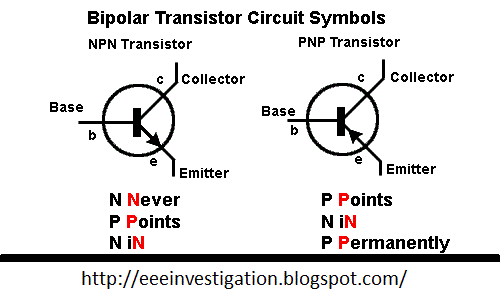

PNP and NPN transistors have identical characteristics, with the exception that the voltage and current biasing directions are reversed for any of the three possible configurations: common base (CB), common emitter (CE), and common collector (CC) (CC), Because the base terminal of a PNP transistor is always biased negative concerning the emitter. As a result, the collector circuit carries the entire emitter current. The leftover hole is captured by the collector and reaches beyond the negatively biased collector-base area, causing collector current to form. The p-type material’s hole mixes with the n-type material to form the base current. The majority charge carrier is pushed toward the base by the emitter-base junction, resulting in the emitter current. PNP’s emitter-base junction is forward biased, while the collector-base junction is reverse biased. PNP transistors have a p-type base and an n-type emitter and collector. Emitter, base, and collector are its three terminals. Two p-type blocks and one n-type block make up the PNP transistor. Difference Between NPN and PNP Transistor.In this case, the emitter voltage of T3 is only 0.6V above Vb3 and the collector voltage Vc3 is even below Vc1,2.

This stepwise DC increase is not wanted - it can be avoided by using a pnp instead of npn. * Next stage (T3): Vb3=Vc1,2 (DC coupling) and Vc3 some volts above Vc1,2. amplifier (T1 and T2) with DC voltages Vc1,2 at the collectors (some volts).
#Npn vs pnp transistor series#
If you want to use two DC-coupled transistors in series (example: npn-differential amplifier with an additional stage), the DC quiescent voltage would increase from stage to stage: The combination of npn and pnp transistors is mostly used with respect to the DC quiescent voltages. The collector current Ic is a function of the base-emitter voltage Vbe with an exponential characteristic - that means, there is a (rather small) current Ic also below this 0.6 volts. However, in case you want a linear operation (as for amplifiers) it is better (even more correct) not to speak about "turn-on". I think now you had a nice points to help me, rather than nothing.Ĭlick to expand.You are correct when you state that it is the voltage between base and emitter that "turns on" the transistors. In which applications the circuit will be used?. If so, why need be used PNP transitor series with the NPN transistor?.ģ) What is the main purpose of the series NPN and PNP transistors?. So, meaning that, the PNP transistor will not be turn ON. But here, the base voltage is higher than the emitter voltage. So, in this case:ġ) Is the both transistors will be turn ON at the same time, since the base voltage applied to the transistors are at the same time?.Ģ) According to the working principle of the PNP transistor (which is explained above), the transistor will turn ON when the base voltage is lower (0.6V) than emitter voltage. In series NPN and PNP transistors, Both base are tied together and connected to the voltage source and both emitters of the NPN and PNP transitor is also tied together. Here, I have a question on the series NPN and PNP transitors. This principle I knew it, when the emitter is connected to the ground through resistor where the NPN transitor is used in the circuit and when the collector is connected to the ground through resistor where the PNP transistor is used in the circuit. Similarly, the PNP transistors will turn ON, when the base voltage is 0.6V lower than the emitter voltage. Yes, I knew that NPN transistor will turn ON when the base voltage 0.6V higher than the emitter voltage.


 0 kommentar(er)
0 kommentar(er)
